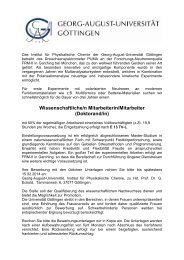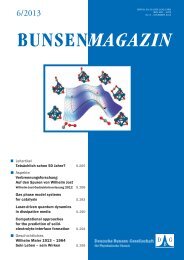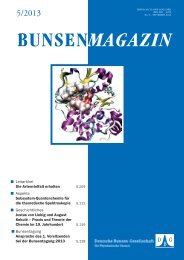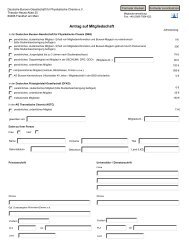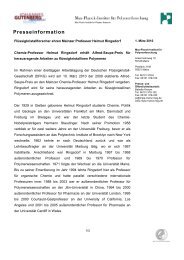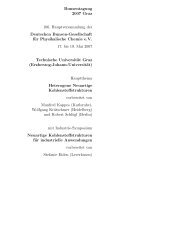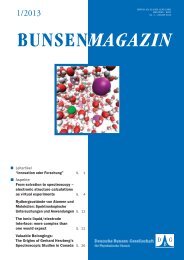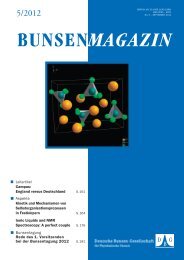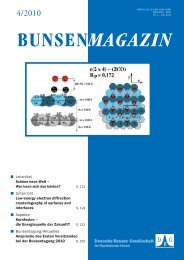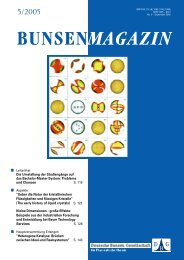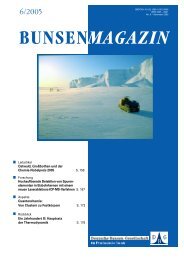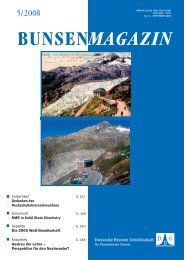BUNSENMAGAZIN - Deutsche Bunsengesellschaft für ...
BUNSENMAGAZIN - Deutsche Bunsengesellschaft für ...
BUNSENMAGAZIN - Deutsche Bunsengesellschaft für ...
Erfolgreiche ePaper selbst erstellen
Machen Sie aus Ihren PDF Publikationen ein blätterbares Flipbook mit unserer einzigartigen Google optimierten e-Paper Software.
DEUTSCHE BUNSEN-GESELLSCHAFT<br />
troscopy. The basic pulse sequence for a 1 H- 13 C Heteronuclear<br />
Multiple-Quantum Correlation (HMQC) experiment is depicted<br />
in Figure 11. 48 As in homonuclear DQ-NMR, the fi rst half of the<br />
REDOR recoupling is identifi ed as the excitation period, and<br />
the second as the reconversion period. In between, HMQC evolution<br />
occurs during t 1 . Evolution due to the 13 C chemical shift<br />
that would lead to additional signal losses is fully refocused<br />
by p-pulses during excitation, evolution and reconversion (in<br />
simple words: its effect is undone).<br />
Figure 11: Basic pulse sequence of REPT-HMQC. The I-channel is usually 1 H,<br />
while the S-channel often refers to 13 C, 15 N or 31 P. REPT means recoupled<br />
polarisation transfer and indicates that the pulse sequence works on initial<br />
I-channel magnetisation, and thus does not require cross-polarisation. Setting<br />
n = 0 corresponds to a recoupling time of 2t R . 48<br />
Indeed, the absence of coherent line-narrowing pulse schemes,<br />
which are often rather sensitive to experimental imperfections,<br />
renders this experiment fairly robust. The recoupled polarisation<br />
transfer (REPT) technique is highly versatile in that it<br />
either allows recording of rotor-synchronized 1 H- 13 C chemical<br />
shift correlation spectra or the determination of even weak 1 H-<br />
13 C dipolar coupling constants by means of spinning sideband<br />
analysis in the indirect dimension of the experiment. Again,<br />
these sidebands are generated by rotor encoding of the reconversion<br />
Hamiltonian. 46<br />
3. SELECTED APPLICATIONS<br />
The versatility of solid-state NMR spectroscopy to elucidate<br />
both the structure and dynamics of (self-)organized possibly<br />
functional aggregates is demonstrated based on selected examples<br />
mainly taken from our laboratory. The rather recent<br />
applications are sorted with respect to the major interaction<br />
or driving force that governs the assembly into macro- or supramolecular<br />
systems.<br />
3.1. HYDROGEN-BONDING<br />
Currently, much interest is focussed on the controlled, rational<br />
design of well-ordered structures that are based on fairly weak<br />
non-covalent interactions such as hydrogen bonds. Though<br />
this approach in principle includes crystals (e.g. in the context<br />
of crystal engineering), many hydrogen-bonded aggregates<br />
crystallize rather poorly rendering single-crystal X-ray structure<br />
analysis diffi cult. In contrast, ultrafast magic-angle-spinning<br />
solid-state NMR is a useful and sensitive tool for the study<br />
of such materials. In particular, the proton chemical shift allows<br />
for a direct detection of local structural environments<br />
UNTERRICHT<br />
and facilitates an estimation of hydrogen-bonding strengths. 50<br />
Indeed, protons involved in hydrogen-bonded structures typically<br />
exhibit well-resolved 1 H chemical shifts, mainly between 8<br />
and 20 ppm. Moreover, correlations between the 1 H isotropic<br />
chemical shifts and the hydrogen-bond strength specifi ed by<br />
O•••H or O•••O distances from single-crystal analyses have<br />
been established. 51 Further resolution may be obtained from<br />
1 H double-quantum 1 H NMR methods (see above) that not<br />
only provide precise information on proton-proton distances on<br />
length scales of up to 0.35 nm but also identify proton positions<br />
in arrays of multiple hydrogen bonds. In this way, dynamic<br />
processes involving molecular recognition 52 or formation of hydrogen-bonded<br />
complexes 50 as well as proton conducting materials<br />
53 can be investigated in detail.<br />
In a rather early case-study, both the thermodynamics and<br />
kinetics of the tautomeric rearrangements of ureidopyrimidinone-based<br />
supramolecular polymers with quadruple hydrogen<br />
bonds was elucidated. The thermally induced and irreversible<br />
transition from pyrimidinone to pyrimidinol could be monitored<br />
via temperature-dependent 2D- 1 H double-quantum spectra<br />
since the two tautomeric structures are involved in different<br />
arrays of quadruple hydrogen-bonds that can be distinguished<br />
by their characteristic DQ peak pattern, thus facilitating an extraction<br />
of the keto/enol ratio present in the sample. It was<br />
found that the rearrangement is associated with an Arrhenius<br />
activation energy of 145 � 15 kJ mol -1 , which contains contributions<br />
from the breaking of hydrogen-bonds and subsequent<br />
reorientation of the polymer chain. 54<br />
Figure 12: Schematic representation of the thermally induced, irreversible<br />
transition from pyrimidin-one to pyrimidin-ol and their characteristic distinguishable<br />
DQ peak pattern. 54<br />
Artifi cial chromophoric receptors for biologically active molecules<br />
have attracted considerable attention from the viewpoint<br />
of molecular recognition. Indeed, barbiturates show very selective<br />
affi nities to binding adenine or its derivatives rendering<br />
them of interest for possible diagnostic applications. By means<br />
of 1 H- 1 H double-quantum and 1 H- 13 C chemical shift correlation<br />
NMR, we obtained detailed insights into packing and (self-)aggregation<br />
of the enolizable chromophor 1-n-butyl-5-(4-nitrophenyl)<br />
barbituric acid that offers adjustable hydrogen-bonding<br />
sites. While in solution, depending on the solvent, up to four<br />
67



